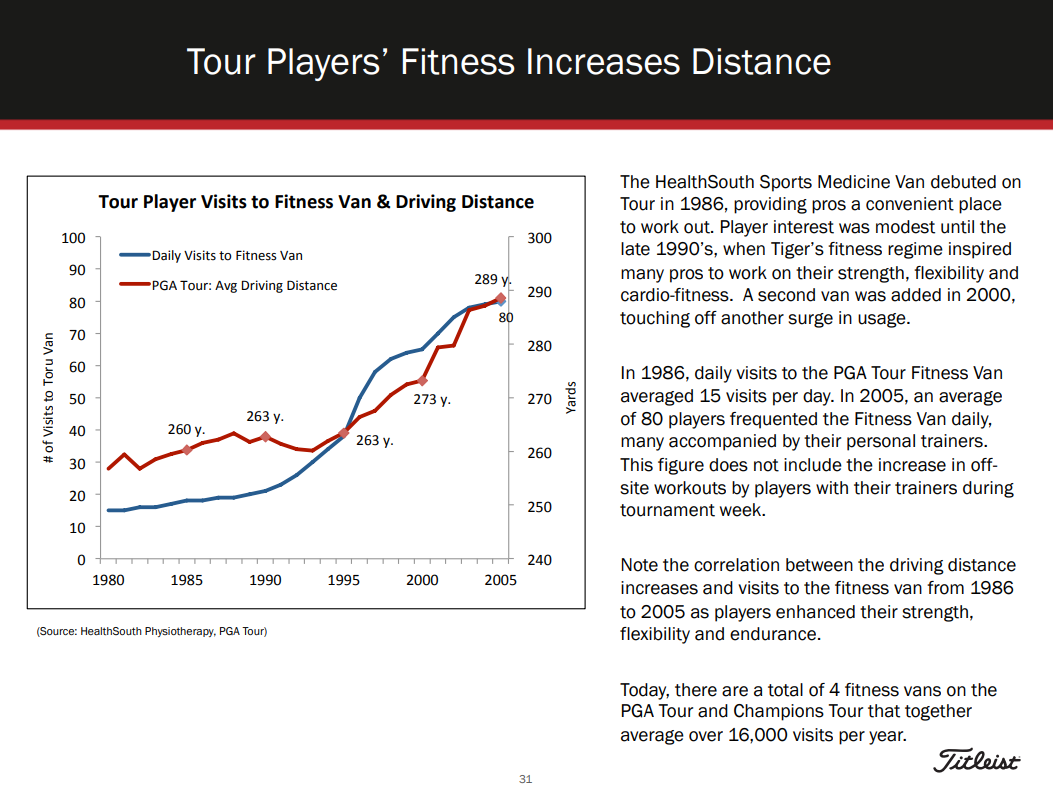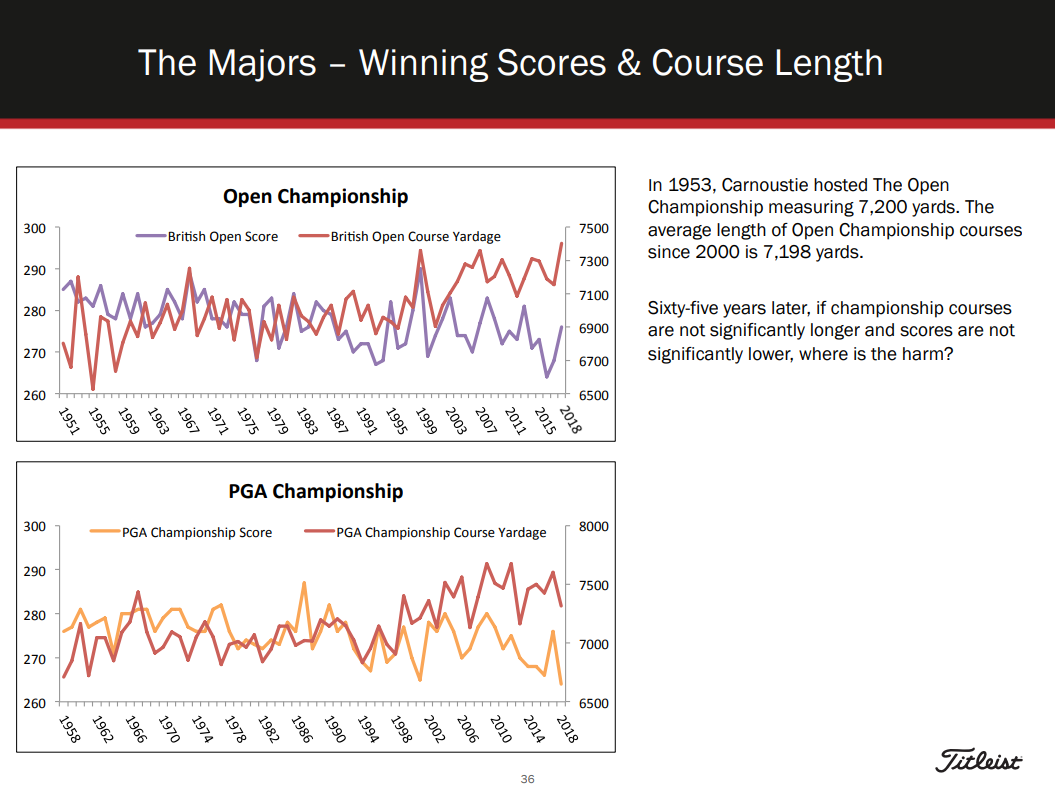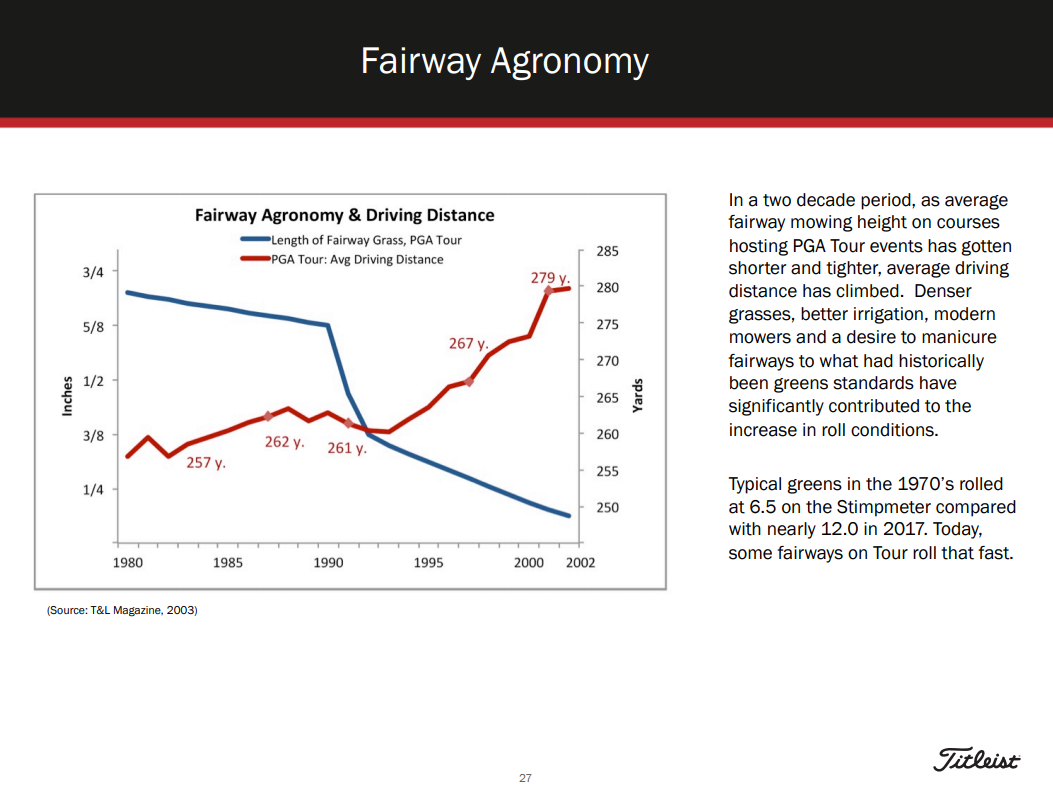In the wake of the USGA and R&A’s latest distance study, it’s no surprise that you won’t find much support for a rollback from golf equipment manufacturers. However, the majority have either been entirely silent or have, so far, chosen words with excruciating caution. For what it’s worth, our colleague and contributor, Rick Young, suggests that may be about to change.
To date, Titleist has been an exception, and while it’s safe to assume it has more on its mind than it has shared publicly, the company has made it clear since the USGA and R&A started sniffing around in earnest that it’s equally opposed to both any sort of equipment rollback and bifurcation.
If you believe both options should be off the table, Titleist is with you.
Given the company’s willingness to speak out against some of the solutions being floated to resolve golf’s distance problem, it shouldn’t come as any particular surprise that, yesterday afternoon, Titleist CEO & President, David Maher, offered up A Perspective on the Distance Insight Report. It’s well worth the two minutes it will take you to read it.
Spoiler alert: Titleist’s leadership isn’t particularly interested in rolling back much of anything. The USGA equipment rules are stifling as it is. They leave minimal opportunity for innovation (that’s especially true with the golf ball). It should go without saying that the idea that we need to rewind technology, whether ball, club, or both, and toss out a decade or few’s worth of advancements and the intellectual property that came with them isn’t likely to garner much support among equipment makers. That part should be obvious enough.
Much of Maher’s thinking mirrors my own, perhaps no more than in this passage:
“We believe the conclusions drawn in this Report undervalue the skill and athleticism of the game’s very best players and focus far too much on the top of the men’s professional game and project this on golf and golfers as a whole.”
Bottom line, the USGA and R&A are far too focused on the professional game (and the implications it has on course design and architecture), and not focusing nearly enough attention on the other 99.99% of golfers. For most of us, our biggest competitive aspiration is to win the 2nd flight of our Club Championship.
You Can’t Rollback the Athlete
Implicit in the broader statement is that evolution is inherent to nearly every sport. Athletes are becoming bigger, faster, and stronger. At a minimum, new skills emerge, while the values of others are sometimes diminished. This is nothing less than the natural order of things.
As if the contribution of fitness wasn’t obvious enough, in its 2019 presentation on Tradition and Technology in golf, Titleist offered up this slide.
Golf fitness is a significant factor in distance gains. Should the equipment devolve because of it? Would the governing bodies of other sports make similar arguments?
Is anyone suggesting that every basketball hoop in the world should be raised two feet? Should the weight of the balls be increased because of the pro game has evolved from ball control and mid-range jumpers to a sport that’s played almost exclusively above the rim and beyond the arc?
The guys playing in 40-and-over rec leagues aren’t dunking and we don’t have Steph Curry’s range. We’re also not obsoleting our golf courses.
Even though I just made one, I’m not a fan of cross-sport analogies. Golf is different, and I’ll concede as much. The obvious response to the argument I just made is that that, unlike golf, basketball equipment isn’t significantly different than it’s always been.
True story.
What’s changed in basketball is the athletes. What’s changed in golf in the decade-plus since the USGA implemented its last distance limiting regulation, is also the athlete.
The USGA knows this, and yet the consistent response is to look at the equipment. It’s the low-hanging fruit. It’s one of the very few pieces of a complex equation that it can directly control.
Maher’s position is that the current equipment regulations are working and that the USGA is overstating the correlation between increased distance and the diminished skill necessary to succeed at the professional level.
Golf equipment (clubs and balls) has historically been highly regulated, and these regulations have been effective in setting upper limits on equipment performance and ensuring that the best golfers separate themselves with their talent, skill, and training while using equipment best suited to their games. The ability to consistently achieve distance with accuracy, and convert this into low scores, remains a special and elusive skill. In fact, the Report itself shows that hitting distance on the PGA Tour decreased in 6 of the past 13 years, including 2019. We believe this helps to affirm the effectiveness of regulatory efforts, particularly those adopted since the early 2000s, which continue to achieve their desired intent of setting boundaries around future distance increases while also rewarding skill and encouraging innovation.
He’s not wrong. The USGA’s distance charts are full of peaks and valleys, and from one year to the next, distance is down nearly as often as it’s up. It’s also true that the trendlines show gains, but there’s been no attempt to normalize the data. What’s not accounted for in the USGA’s charts is the impact of both the venue and the field have in average distance from event to event and year to year. Soft conditions vs. dry conditions, different golfers on the course. It’s apples and oranges at best.
What’s the Solution?
My only issue – and I suppose it’s a small one – with Maher’s statement is that it stops short of offering a position on a possible solution (assuming he believes there’s actually a problem).
Let’s not rollback the gear. That much is clear.
Bifurcation is off the table as well. Titleist’s position on that has been evident since former CEO Wally Uihlein argued The Case for Unification.
It’s not unreasonable to take a wait and see approach and read the tea leaves as the fall, but I do wonder; if pushed to make a specific recommendation, where might Titleist and Maher land?
Evolution is natural. Do nothing. – That’s certainly a possibility. Charts provided in its Traditions and Technology Report suggest that longer courses don’t have a significant impact on scoring.
Grow the Grass?
Could Titleist be a proponent of our preferred solution – Grow the Grass? I understand that architectural purists hate the idea every bit as much as I loathe the idea of rolling back the equipment, but that same Tradition and Technology report provides some compelling evidence for rolling back the lawnmower.
I’m not suggesting we rollback greens to 6.5. I’m not opposed to firm and fast greens, but given that fairway height has decreased by more than a half an inch, perhaps it’s reasonable to shift the conversation a bit more towards the amount of distance attributable to excessive roll.
At a minimum, if one of the primary concerns with increased distance is that it will eventually obsolete classic venues, shouldn’t the scope of any solution including maintaining fairway length somewhat closer to what the architect was working with at the time?
Waiting for the Chips to Fall
For now, it’s more of the same. It’s reasonable to expect the equipment manufacturers will weigh in and potentially speak out with a bit more zeal against a rollback. There’s real money on the line for them – and frankly, as far as the recreational game is concerned, it’s a stupid idea.
Proposals for solutions will have to wait as companies decide how much of their data – some of which will almost certainly directly contradict the USGA’s findings – to share. For now, the approach is one of unity – working together because we’re all in this together. If the USGA pushes closer to a doomsday scenario for manufactures – a rollback of the ball, the clubs, or both, the tone for the manufactures and the spirit of cooperation may shift dramatically.
One thing is for sure; we’re a long way from putting this one to bed.
The post Titleist CEO, David Maher, Responds to the Distance Insights Report appeared first on MyGolfSpy.




